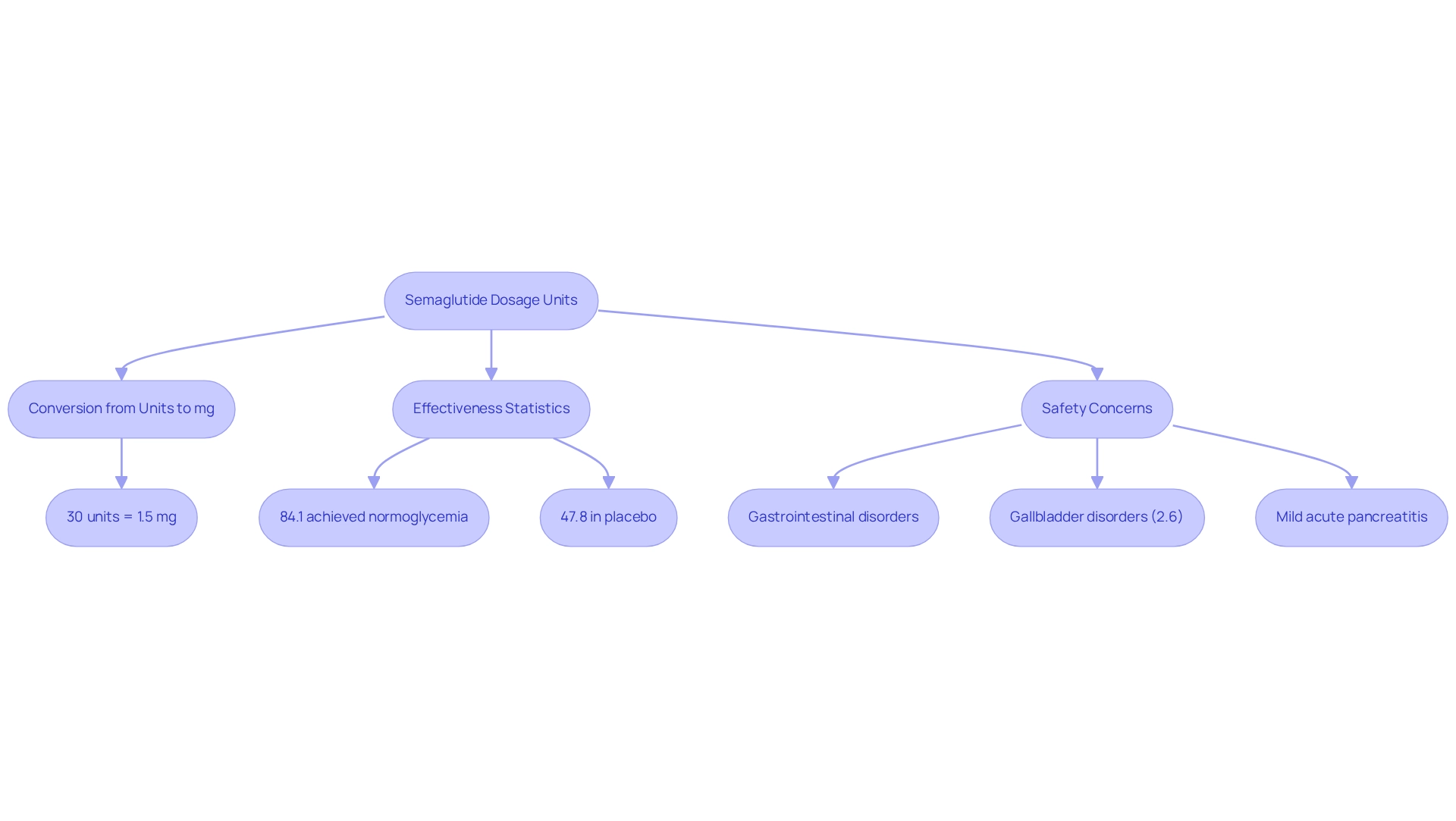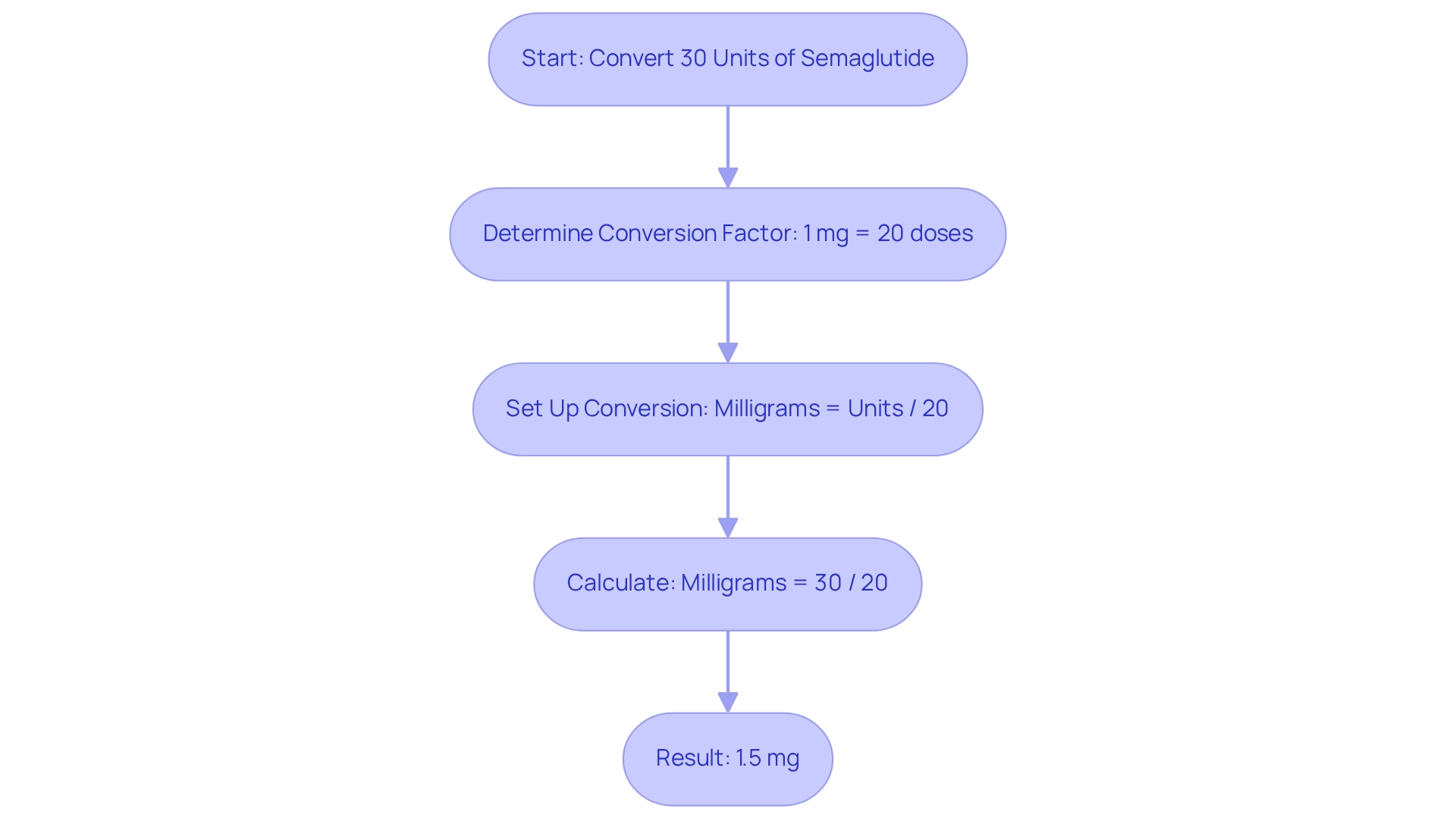Overview
Understanding semaglutide can feel overwhelming, but we’re here to help. Did you know that 30 units of semaglutide is equivalent to 1.5 mg? This conversion is based on the fact that 1 mg corresponds to 20 units. It’s crucial to grasp this information as it plays a significant role in effective weight management and diabetes control.
By providing a straightforward calculation method, the article emphasizes the importance of knowing your dosage. This knowledge can empower you on your journey, making it easier to navigate your treatment plan. Remember, together, we can achieve your goals and find the right path for you.
Introduction
In the realm of modern medicine, semaglutide has emerged as a groundbreaking solution for weight management and diabetes control. This injectable medication, particularly known through its brand Wegovy, operates on a unique dosing system measured in units rather than traditional milligrams. This distinction is critical for both healthcare providers and patients, as accurate dosing can significantly impact treatment outcomes.
With studies demonstrating impressive effectiveness and safety profiles, understanding the nuances of semaglutide administration becomes essential for those seeking to harness its benefits. Have you ever felt overwhelmed by the complexities of managing your health? From mastering the conversion of units to milligrams to adhering to best practices in injection techniques, this article delves into the vital information needed for effective use of semaglutide. Together, we can navigate your health journey with confidence, ensuring you are well-equipped to achieve your goals.
Understand Semaglutide and Its Dosage Units
Semaglutide, especially in its Wegovy form, serves as a vital medication for those navigating weight management and diabetes control, delivered through injection. It’s important to recognize that this medication is measured in increments rather than milligrams (mg), a detail crucial for ensuring accurate dosing. For instance, 1 mg of the medication translates to 20 increments when using a standard insulin syringe. So, when a healthcare provider prescribes a dose of 30 units, it raises the question of how many mg is 30 units of semaglutide, which corresponds to 1.5 mg of the medication.
Recent studies highlight the effectiveness of this treatment, showing that:
- 84.1% of participants achieved normoglycemia by week 68, compared to 47.8% in the placebo group.
- Case studies focused on the medication’s safety have pointed out gastrointestinal, hepatobiliary, and cardiovascular disorders as significant areas of concern, with gallbladder-related disorders reported in 2.6% of participants.
- Mild acute pancreatitis was observed in three individuals, all of whom recovered during the trial.
For both healthcare professionals and patients, understanding how many mg is 30 units of semaglutide in relation to the conversion between increments and milligrams is essential. This knowledge not only facilitates the correct administration of the medication but also supports effective weight management and diabetes regulation. Together, we can make this medication a valuable ally in your health journey, empowering you to achieve your goals.
Convert 30 Units of Semaglutide to Milligrams
Understanding how many mg is 30 units of semaglutide can feel overwhelming, but we’re here to help. To make this straightforward, follow this simple formula:
-
Determine the conversion factor: One milligram of the medication is equal to 20 doses.
-
Set up the conversion: To find out how many milligrams are in 30 units, divide the number of units by the conversion factor:
Milligrams = Units / 20
Milligrams = 30 / 20 = 1.5 mg
Thus, 30 units of semaglutide corresponds to 1.5 mg. This calculation is vital for ensuring you receive the correct dosage as prescribed by your healthcare provider. Following dosing guidelines is crucial; studies show that individuals using this medication experience 40% fewer hypoglycemic events compared to those on insulin therapy alone.
Additionally, Wegovy is FDA-approved for weight management in adults who are overweight or obese. This makes accurate dosing even more critical for effective weight management and improved metabolic health. Remember, it’s essential to adhere to your physician’s recommendations regarding appropriate dosage and administration methods, including alternating administration locations to prevent irritation. Together, we can achieve your goals, and this highlights the importance of accurate dosing in achieving optimal health outcomes and overall well-being.
Follow Best Practices for Semaglutide Administration
Administering semaglutide correctly is essential for maximizing its effectiveness, and we understand that this process can feel overwhelming. Here are some key best practices to help you navigate this journey:
- Administration Site: Choose appropriate administration sites like the abdomen, thigh, or upper arm. Regularly rotating these sites can minimize irritation and enhance your comfort.
- Preparation: Before the procedure, take a moment to wash your hands thoroughly and disinfect the site with an alcohol swab. This simple step helps reduce the risk of infection, ensuring your safety.
- Syringe Handling: Always use a new needle for each injection. This practice significantly reduces the likelihood of infection and ensures the quality of your treatment.
- Injection Technique: Hold the syringe at a 90-degree angle to your skin. Insert the needle swiftly and inject the medication steadily. After injecting, keeping the syringe in place for a few seconds helps ensure the complete dose is delivered.
- Disposal: Safely dispose of used needles in a designated sharps container to prevent injury and contamination.
By following these best practices, you not only improve your adherence to the treatment but also align with expert guidelines, ensuring that the medication is administered safely and effectively. Remember, studies indicate that proper injection techniques can lead to improved patient outcomes. Together, we can achieve your health goals, and your commitment to these guidelines is a significant step in that direction.
Monitor Your Response to Semaglutide
Monitoring your body’s reaction to the medication is essential for optimizing your treatment. We understand that this journey can be overwhelming, but by following these key steps, you can take charge of your progress:
- Track Weight Changes: Weigh yourself regularly to observe any fluctuations. This data is vital for determining whether your dosage requires adjustment.
- Note Side Effects: Document any side effects you experience, such as nausea, vomiting, upset stomach, stomach pains, constipation, diarrhea, heartburn, acid reflux, belching and gas, dizziness, headaches, and fatigue. Sharing this information with your healthcare provider is crucial. Understanding your body’s reactions can guide necessary modifications.
- Schedule Regular Check-Ins: Arrange consistent appointments with your healthcare provider to review your progress and address any concerns. These discussions facilitate timely adjustments to your treatment plan, enhancing overall effectiveness.
- Adjust Lifestyle Factors: Enhance your treatment with a balanced diet and regular exercise. These lifestyle changes can significantly boost the effectiveness of semaglutide, and understanding how many mg is 30 units of semaglutide can lead to better weight management outcomes.
By actively engaging in this monitoring process, you can collaborate effectively with your healthcare provider to tailor your treatment plan. Remember, together, we can achieve your goals and ensure the best possible results on your weight loss journey.
Understand Potential Side Effects and Interactions
Semaglutide, like any medication, can lead to various side effects that you should be aware of as you navigate your weight loss journey:
- Gastrointestinal Issues: It’s common to experience nausea, vomiting, diarrhea, and constipation, especially during the initial stages of treatment. These symptoms often lessen as your body adapts to the medication, so be patient with yourself during this transition.
- Injection Site Reactions: You may notice localized reactions such as redness, swelling, or itching at the site of injection. This is a normal response and should resolve on its own.
- Hypoglycemia: While semaglutide generally poses a lower risk of hypoglycemia compared to other diabetes therapies, it can still occur, particularly when combined with other glucose-lowering medications. It’s important to remain vigilant and monitor your blood sugar levels to prevent any low blood sugar episodes.
- Allergic Reactions: Although rare, severe allergic reactions can happen. If you experience symptoms like difficulty breathing or facial swelling, please seek immediate medical attention.
To effectively manage these side effects, we encourage you to maintain open communication with your healthcare provider about any other medications you are taking. This proactive approach can help mitigate potential interactions and ensure a safer treatment experience. Regular check-ins with healthcare professionals can enhance your outcomes, highlighting the importance of collaborative care in managing your semaglutide treatment. Remember, we’re here for you, and together, we can achieve your goals.
Conclusion
Understanding semaglutide and its unique dosing system is vital for effective weight management and diabetes control. This injectable medication, marketed primarily as Wegovy, operates in units rather than milligrams. This emphasizes the importance of accurate dosing for optimal treatment outcomes. By mastering the conversion from units to milligrams, both patients and healthcare providers can ensure that the correct dosage is administered, maximizing the benefits of semaglutide.
Implementing best practices for administration enhances the effectiveness of semaglutide. Proper injection techniques, careful site selection, and hygiene are essential components that contribute to successful treatment. Regular monitoring of weight changes and side effects allows for timely adjustments to the treatment plan, fostering a collaborative approach between patients and healthcare providers. Together, we can navigate this journey toward better health.
Moreover, being aware of potential side effects and interactions can significantly impact the overall treatment experience. Open communication with healthcare professionals is crucial for addressing any concerns and ensuring patient safety. As you navigate your health journey, remember that the knowledge and strategies surrounding semaglutide empower you to achieve your weight management and diabetes control goals with confidence. We’re here for you every step of the way.
Frequently Asked Questions
What is semaglutide and its primary use?
Semaglutide, particularly in its Wegovy form, is a medication used for weight management and diabetes control, administered through injection.
How is semaglutide measured for dosing?
Semaglutide is measured in increments rather than milligrams (mg). For example, 1 mg of semaglutide translates to 20 increments when using a standard insulin syringe.
How do you convert units of semaglutide to milligrams?
To convert units to milligrams, use the formula: Milligrams = Units / 20. For example, 30 units of semaglutide equals 1.5 mg (30 / 20 = 1.5).
What are the effects of semaglutide in studies?
Recent studies show that 84.1% of participants achieved normoglycemia by week 68, compared to 47.8% in the placebo group. Additionally, individuals using semaglutide experienced 40% fewer hypoglycemic events than those on insulin therapy alone.
What safety concerns are associated with semaglutide?
Safety studies have identified gastrointestinal, hepatobiliary, and cardiovascular disorders as significant concerns. Gallbladder-related disorders were reported in 2.6% of participants, and mild acute pancreatitis was observed in three individuals, all of whom recovered during the trial.
What is the importance of understanding the correct dosage of semaglutide?
Understanding the correct dosage is crucial for effective administration, weight management, and diabetes regulation. Accurate dosing supports optimal health outcomes and overall well-being.
Is Wegovy FDA-approved, and for what purpose?
Yes, Wegovy is FDA-approved for weight management in adults who are overweight or obese.



















